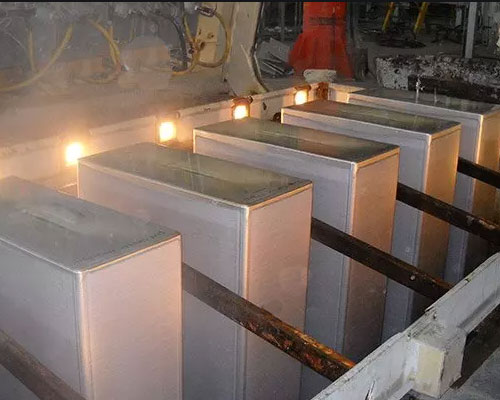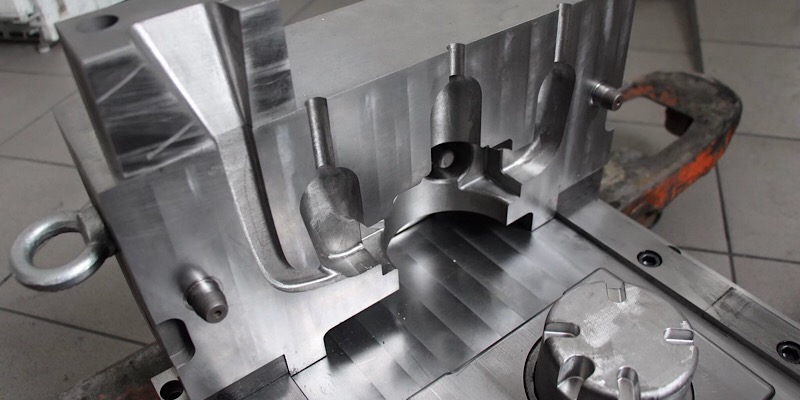What makes a Casting Foundry an important partner in metal fabrication
Discovering the Important Applications and Uses of Light Weight Aluminum Shop in Modern Production
Light weight aluminum factories play a vital duty in modern-day manufacturing, serving diverse markets with their special properties. From automobile parts that enhance fuel effectiveness to aerospace structures that prioritize weight, aluminum's flexibility appears. Its applications encompass building and consumer electronics, highlighting its toughness and power efficiency. However, the developments in aluminum spreading strategies and future fads necessitate a closer assessment, as they may redefine its impact on manufacturing.
The Duty of Light Weight Aluminum Foundries in Automotive Manufacturing
As the automotive sector increasingly prioritizes light-weight materials to enhance gas effectiveness and performance, light weight aluminum shops have actually come to be crucial factors to producing procedures. These factories focus on creating components that fulfill the rigid demands of modern-day automobiles, such as engine blocks, transmission housings, and architectural components. Light weight aluminum's beneficial residential or commercial properties-- such as high strength-to-weight proportion, rust resistance, and excellent thermal conductivity-- make it an excellent option for auto applications.
Moreover, light weight aluminum foundries use advanced spreading strategies, including die spreading and sand spreading, to create complex and durable components. This ability permits manufacturers to enhance layouts for performance while lessening weight. The use of light weight aluminum likewise sustains sustainability objectives, as it is highly recyclable and lowers energy consumption in cars. By promoting the integration of aluminum right into auto layout, factories play a crucial role in shaping the future of the vehicle sector, advertising performance and innovation throughout the board.
Aerospace Applications: Lightweight Solutions for Trip
Light weight aluminum foundries play a significant function in the aerospace market, where the need for light-weight materials is critical for improving gas effectiveness and efficiency in airplane. The special properties of aluminum, including its high strength-to-weight ratio and deterioration resistance, make it an excellent choice for various aerospace components. These components include structural components, engine casings, and touchdown equipment, which add to total airplane efficiency.
Using aluminum alloys, particularly those developed through innovative spreading methods, enables the production of intricate layouts and complicated shapes while reducing weight. Additionally, aluminum's recyclability straightens with the aerospace sector's sustainability objectives, reducing ecological influence. With constant developments in aluminum shop technologies, manufacturers can optimize production processes, bring about raised performance and decreased costs. As the aerospace field progressively prioritizes technologies that improve efficiency, aluminum foundries will certainly remain indispensable to establishing lightweight remedies for modern-day flight.
Building and Building And Construction: Enhancing Structural Honesty
In the building and building and construction market, a substantial focus is put on improving structural stability through using light weight aluminum. Known for its high strength-to-weight proportion, aluminum supplies sturdiness without endangering on weight, which is vital in modern-day building styles. Its resistance to deterioration even more assures longevity, making it a suitable material for different architectural components, including light beams, frames, and cladding.
Aluminum additionally facilitates ingenious layout possibilities, enabling architects and engineers to create visually pleasing frameworks while keeping safety and security standards. The material's adaptability allows its application in both domestic and industrial tasks, from skyscrapers to bridges. Additionally, improvements in light weight aluminum shop strategies have actually improved the precision of light weight aluminum parts, guaranteeing they fulfill stringent building codes. In general, the combination of aluminum in building not only enhances structural stability however likewise adds to lasting building methods, offered its recyclability and energy-efficient manufacturing techniques.
Customer Electronics: The Increase of Aluminum in Technology
In the domain name of customer electronic devices, light weight aluminum has actually gotten importance because of its lightweight design advantages and remarkable thermal conductivity. This shift not only enhances item transportability however likewise improves device efficiency by successfully dissipating warmth. As innovation remains to develop, the role of light weight aluminum in developing sleek and efficient tools is progressively significant.
Lightweight Layout Benefits
As consumer electronics advance, the demand for lightweight yet sturdy materials has actually risen, making light weight aluminum an increasingly preferred option among producers. Its reduced density permits the creation of streamlined gadgets that are very easy to make use of and carry, substantially improving portability. The strength-to-weight proportion of aluminum warranties that products can hold up against everyday damage without jeopardizing performance. In addition, the malleability of light weight aluminum enables makers to design complex shapes and kinds, further adding to innovative aesthetics and performance. This light-weight characteristic likewise plays an important duty in energy effectiveness, as lighter tools require less power to run. Consequently, light weight aluminum not just fulfills the progressing visual demands however likewise straightens with the modern focus on sustainability in consumer electronic devices.
Thermal Conductivity Conveniences
Thermal conductivity is a vital consider the efficiency of consumer electronics, and light weight aluminum master this domain name. Its high thermal conductivity enables effective warmth dissipation, which is essential for maintaining ideal operating temperature levels in tools such as smart devices, laptops, and gaming consoles. By assisting in fast warmth move far from delicate parts, light weight aluminum aids prevent overheating, thus improving performance and extending gadget durability. The lightweight nature of aluminum enhances its thermal residential or commercial properties, making it a perfect choice for portable modern technology. As suppliers significantly focus on performance and energy efficiency, light weight aluminum's duty in thermal administration ends up being much more substantial, bring about its expanding fostering in contemporary electronic styles. This pattern highlights aluminum's relevance in customer electronics development.
Marine Industry: Deterioration Resistance in Harsh Atmospheres
Corrosion resistance is a critical variable in the marine market, where equipment and structures are consistently revealed to rough deep sea environments. Light weight aluminum, especially in its alloy kinds, uses significant benefits hereof. Its all-natural oxide layer supplies a protective obstacle that avoids deterioration, making it suitable for vessels, docks, and various other marine applications.
Marine-grade light weight aluminum alloys, such as read what he said 5083 and 6061, are specifically made to endure the corrosive results of saltwater and climatic conditions. These alloys not only stand up to rust yet also keep structural stability and strength gradually. Applications vary from hulls and superstructures of ships to components in overseas systems.
The lightweight nature of light weight aluminum further improves its viability, enabling enhanced gas efficiency and simplicity of handling - aluminum foundry. As the aquatic sector remains to concentrate on resilience and efficiency, light weight aluminum remains a necessary material choice for withstanding deterioration sought after marine settings
Advancements in Light Weight Aluminum Casting Techniques
While conventional aluminum spreading methods have actually served the market well, current technologies are changing the landscape of aluminum manufacturing. Methods such as 3D printing of mold and mildews and cores are gaining traction, permitting fast prototyping and decreased preparations. This innovation makes it possible for manufacturers to create complex geometries that were previously challenging to accomplish with traditional casting methods. Additionally, developments in die-casting innovation, including using high-pressure die-casting (HPDC), have improved the precision and surface coating of cast aluminum components, resulting in enhanced efficiency in numerous applications.
In addition, the adoption of investment casting has actually permitted for higher layout flexibility and minimized product waste. Aluminum Casting. Technologies in alloy compositions are likewise substantial, as they enhance mechanical buildings and rust resistance. Generally, these advancements not only improve manufacturing processes yet also contribute to more sustainable methods within the light weight aluminum foundry field, making it versatile to the developing needs of contemporary manufacturing
Future Fads in Aluminum Shop Production
The future of aluminum shop production is poised for significant improvement through automation, improving performance and precision in producing procedures. Sustainable methods are significantly becoming a concern, as shops seek to reduce their ecological influence while meeting growing governing needs. Additionally, improvements in alloy growth will certainly enable the development of more powerful, lighter products customized for varied applications, driving innovation in the market.
Automation in Shop Processes

Lasting Manufacturing Practices
An expanding focus on lasting production methods is improving the future of light weight aluminum foundry manufacturing. Market leaders are increasingly taking on energy-efficient innovations and reusing initiatives to lessen waste and reduce carbon impacts. The use of recycled light weight aluminum substantially lowers energy consumption contrasted to primary light weight aluminum production, making it a recommended choice for environmentally aware producers. Furthermore, ingenious spreading methods are being created to improve product efficiency and lower discharges. Companies are additionally buying sustainable power sources, such as solar and wind, to power their procedures sustainably. Casting Foundry. By integrating these methods, the light weight aluminum foundry sector not only satisfies governing requirements however additionally reacts to consumer need for greener items, eventually leading the way for a much more lasting production landscape
Advanced Alloy Development
Developments in light weight aluminum alloy growth are readied to play a considerable duty in the future of foundry production, especially as sustainability and efficiency needs escalate. The industry is progressively concentrating on developing high-strength, light-weight alloys that can withstand severe problems while minimizing ecological effect. Scientists are discovering cutting-edge compositions, such as aluminum-lithium and aluminum-scandium alloys, which promise enhanced mechanical buildings and decreased weight. Furthermore, the combination of sophisticated production methods, consisting of additive production and precision casting, enables for more facility geometries and minimized product waste. As regulative pressures and consumer preferences shift towards greener choices, the growth of recyclable and energy-efficient alloys will certainly be essential. The future landscape of light weight aluminum shop manufacturing pivots on these improvements in alloy innovation.

Frequently Asked Concerns
What Are the Environmental Impacts of Aluminum Shop Workflow?
Aluminum foundry procedures can lead to considerable ecological influences, including greenhouse helpful site gas emissions, power usage, and waste generation. Furthermore, improper monitoring of contaminants may bring about dirt and water contamination, affecting local ecosystems and areas.
Exactly How Does Aluminum Recycling Affect Shop Processes?
Aluminum reusing improves foundry procedures by offering a cost-effective basic material, minimizing energy intake and emissions. This lasting method raises effectiveness, minimizes waste, and sustains the circular economic climate, benefiting both makers and the environment.
What Precaution Are Applied in Aluminum Foundries?
Light weight aluminum foundries carry out various precaution, including individual safety devices, appropriate air flow systems, regular safety and Continue security training, fire avoidance procedures, and equipment upkeep procedures to reduce hazards and assure a risk-free workplace for all staff members.
Exactly How Do Foundries Make Certain Top Quality Control in Light Weight Aluminum Spreading?
Factories ensure quality control in aluminum casting with extensive product examinations, exact temperature level surveillance, standardized procedures, and routine screening of actors products. These steps assist keep uniformity, reduce defects, and fulfill sector specifications efficiently.
What Are the Expense Variables in Light Weight Aluminum Shop Production?
Cost elements in aluminum factory production consist of raw product prices, power intake, labor prices, tools upkeep, and overhead expenditures. In addition, manufacturing quantity and intricacy of styles substantially affect total production prices and earnings.
As the vehicle market progressively prioritizes lightweight products to boost gas efficiency and performance, aluminum shops have actually ended up being vital contributors to manufacturing procedures. Light weight aluminum factories play a considerable role in the aerospace industry, where the demand for lightweight materials is paramount for boosting gas effectiveness and efficiency in airplane. Furthermore, developments in aluminum shop methods have enhanced the precision of light weight aluminum elements, ensuring they fulfill rigid building codes. While typical light weight aluminum casting approaches have offered the market well, recent technologies are transforming the landscape of light weight aluminum manufacturing. The usage of recycled light weight aluminum considerably decreases energy intake compared to primary light weight aluminum production, making it a favored choice for eco conscious suppliers.